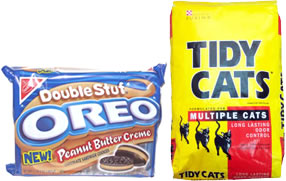Product Contagion
 I recall the first mega-store that opened locally – it happened to be a Meijer store, though now Super Wal-Marts, Super Targets, and other stores that sell everything are common. It was interesting to watch what other shoppers had in their carts as they checked out – a gallon of milk, a floor mop, khaki slacks, and a chainsaw… one could start a creative writing contest in which entrants had to write a story based on shopping carts full of disparate items. As it turns out, there’s a downside to at least some of those weird product juxtapositions. New research shows that products that trigger subconscious feelings of disgust can “contaminate” consumer perceptions of other products.
I recall the first mega-store that opened locally – it happened to be a Meijer store, though now Super Wal-Marts, Super Targets, and other stores that sell everything are common. It was interesting to watch what other shoppers had in their carts as they checked out – a gallon of milk, a floor mop, khaki slacks, and a chainsaw… one could start a creative writing contest in which entrants had to write a story based on shopping carts full of disparate items. As it turns out, there’s a downside to at least some of those weird product juxtapositions. New research shows that products that trigger subconscious feelings of disgust can “contaminate” consumer perceptions of other products.
Products like lard, feminine hygiene items, cigarettes, and cat litter trigger a disgust reaction, as do some less obvious items like mayonnaise and shortening. The research, conducted by Gavan Fitzsimons, a professor of marketing and psychology at Duke’s Fuqua School of Business, and Andrea Morales, an assistant professor of marketing at Arizona State’s W.P. Carey School of Business, was intended to explore how products like these affected consumer perceptions of other items in their shopping carts.
They performed a series of experiments in which participants observed food products placed close to or touching a distasteful product. In all cases, products that touched or rested against disgusting products became less appealing than products that were at least an inch away from the offending products. The effect was also enduring. Participants asked more than an hour after observing the products how much they wanted to try a cookie were less likely to want it if the package of cookies had been in contact with a package of feminine napkins.
The researchers say this behavior is not necessarily irrational, as it likely derives from basic instincts that caution humans against eating foods that have come in contact with insects or other sources of germs…
In one experiment, participants viewed packages of rice cakes — some wrapped in transparent packaging and some in opaque paper carrying a “rice cakes” label –that were touching a container of lard. The rice cakes in the clear packaging were later estimated to have a higher fat content than those in the opaque packaging. [From When Cookies Catch the Cooties.]
It’s interesting that packaging was shown to affect the degree of contagion, with products in clear packaging being the most vulnerable to subconscious contamination.
Clearly, marketers can’t control what shoppers combine in their shopping carts, and once the item is in the cart the consumer is almost certain to buy it anyway. It’s doubtful that this negative association is a long-lasting effect that would tarnish the brand or the consumer’s long term feelings about the product. I’d worry more about pre-shopping cart product contagion – i.e., on the store shelf, in displays, etc. Fortunately, most stores segregate their products by category, and one won’t find cat litter in the cookie aisle. Still, marketers should be aware of this previously unknown downside to clear packaging – while complete transparency assures consumers that the product they are buying is exactly what they expect, it seems that clear packaging subconsciously implies a degree of vulnerability. I’d speculate that in retail environments that aren’t well-lit and spotlessly clean, clear packages might allow the products to be “contaminated” (subconsciously, of course) by their surroundings.
These findings might also provide a minor boost for specialty retailers – products sold in a bakery, for example, may end up seeming more appealing to consumers that similar products sold in the bakery department of a megastore where the items will end up sharing cart space with “contagious” items. In the grand theme of neuromarketing, this new research seems to fit into the general area of priming, in which an individual’s subsequent perceptions or behavior have been influenced by seemingly innocuous stimuli.
